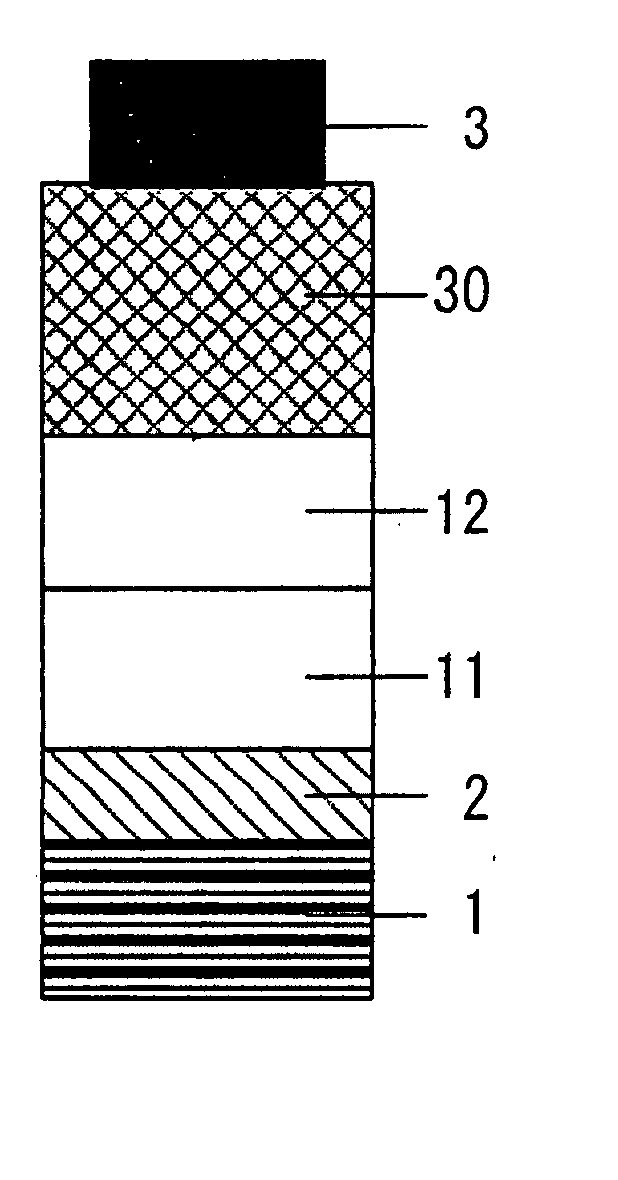Organic electroluminescent devices
a technology of electroluminescent devices and electroluminescent tubes, which is applied in the direction of discharge tube luminescnet screens, natural mineral layered products, transportation and packaging, etc., can solve the problems of limited layer thickness, poor storage stability, and only able to deposit substantially all of the exemplified metal oxide compounds, so as to reduce the driving voltage and maintain the driving durability stability , the effect of diminishing the formation of the hole transfer barrier
- Summary
- Abstract
- Description
- Claims
- Application Information
AI Technical Summary
Benefits of technology
Problems solved by technology
Method used
Image
Examples
reference example 1
Production of Conventional Organic EL Device Using CuPc
[0127] The organic EL device having a lamination structure illustrated in FIG. 7 was produced as Reference Example 1.
[0128] The glass substrate 701 used in this example includes, as a transparent anode electrode (anode electrode layer) 702, a coating of ITO (indium-tin oxide; Nippon Sheet Glass Co., Ltd.) having a sheet resistance of about 10 Ω / □ (10 Ω / sq). Onto the ITO-coated glass substrate 701 was deposited CuPc represented by the following formula:
under vacuum of about 10−6 Torr and at the deposition rate of about 2 Å / sec to form a first hole transportation layer (hole injection layer) 711 having a thickness of about 150 Å.
[0129] Thereafter, onto the first hole transportation layer (hole injection layer) 711 was deposited Alpha(α)-NPD having a hole transporting property under vacuum of about 10−6 Torr and at a deposition rate of about 2 Å / sec to form a second hole transportation layer 712 having a thickness of about 5...
example 1
Production of Organic EL Device According to Present Invention
[0132] The organic EL device having a lamination structure illustrated in FIG. 8 was produced as Example 1.
[0133] A glass substrate 801 used in this example includes, as a transparent anode electrode (anode electrode layer) 802, a coating of ITO (indium-tin oxide; Nippon Sheet Glass Co., Ltd.) having a sheet resistance of about 10 Ω / □. Onto the ITO-coated glass substrate 801 was deposited CuPc under conditions similar to those applied in Reference Example 1 to form a first hole transportation layer 811 having a thickness of about 150 Å. Subsequently, an electron-accepting material, V2O5 (vanadium pentoxide), which is one constitutional element of the present invention, and α-NPD, which is a constitutional material of the second hole transportation layer 802, were co-deposited at a molar ratio (V2O5: α-NPD) of about 4:1 on the first hole transportation layer 811 to form a mixed layer 822 having a thickness of about 100 ...
reference example 2
Production of Conventional Organic EL Device Using 2-TNATA
[0135] The organic EL device having a lamination structure illustrated in FIG. 9 was produced as Reference Example 2. The structure of the organic EL device is similar to that of Reference Example 1 except that the CuPc layer (150 Å) used as the first hole transportation layer in Reference Example 1 was replaced with a 2-TNATA layer (600 Å), described above.
[0136] Namely, a transparent anode electrode (ITO) 902, a first hole transportation layer (2-TNATA) 911, a second hole transportation layer (α-NPD) 912, a luminous layer (Alq) 906, an electron injection layer (Liq) 907 and a cathode electrode layer (903) were deposited, in sequence, on the glass substrate 901 in accordance with the manner described in Reference Example 1 to form an organic EL device.
[0137] In the resulting organic EL device, a DC voltage was applied between ITO (transparent anode electrode 902) and Al (cathode electrode layer 903), and the luminance of...
PUM
| Property | Measurement | Unit |
|---|---|---|
| thickness | aaaaa | aaaaa |
| external quantum efficiency | aaaaa | aaaaa |
| luminance | aaaaa | aaaaa |
Abstract
Description
Claims
Application Information
 Login to View More
Login to View More - R&D
- Intellectual Property
- Life Sciences
- Materials
- Tech Scout
- Unparalleled Data Quality
- Higher Quality Content
- 60% Fewer Hallucinations
Browse by: Latest US Patents, China's latest patents, Technical Efficacy Thesaurus, Application Domain, Technology Topic, Popular Technical Reports.
© 2025 PatSnap. All rights reserved.Legal|Privacy policy|Modern Slavery Act Transparency Statement|Sitemap|About US| Contact US: help@patsnap.com



